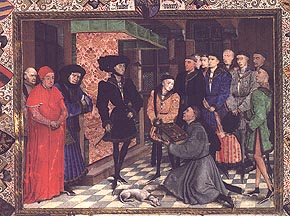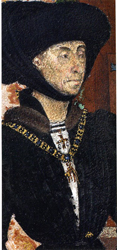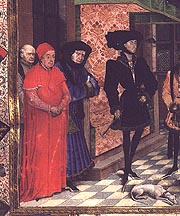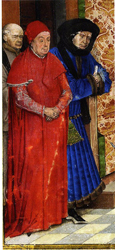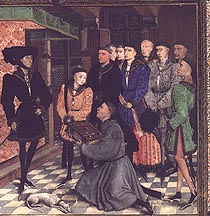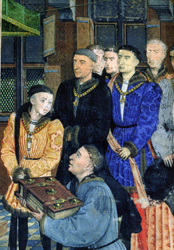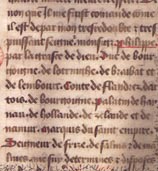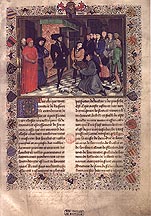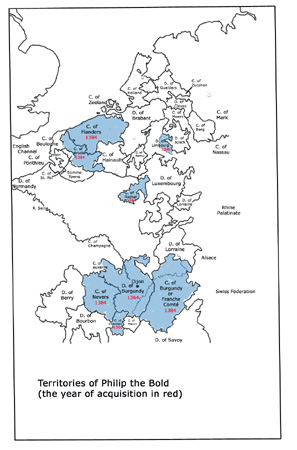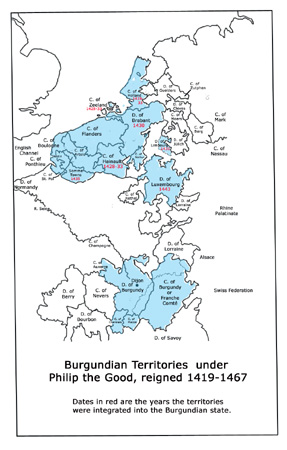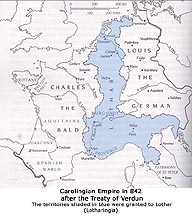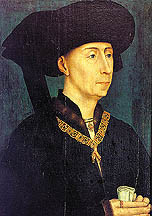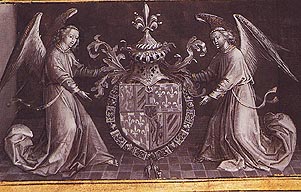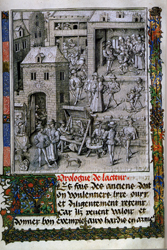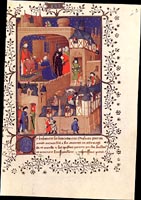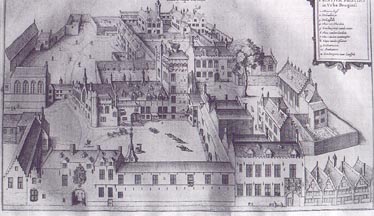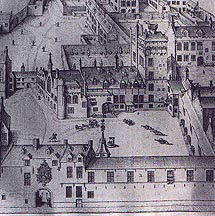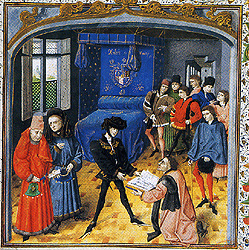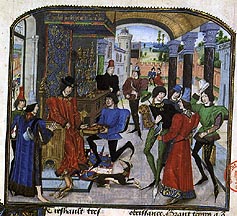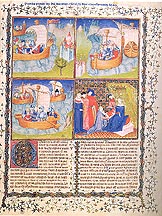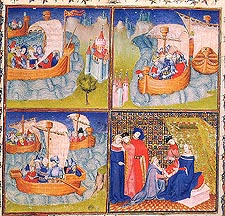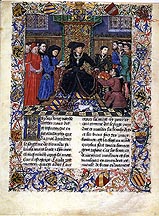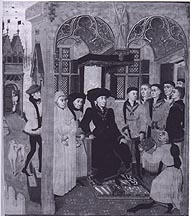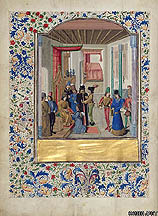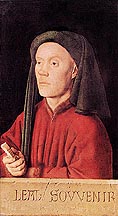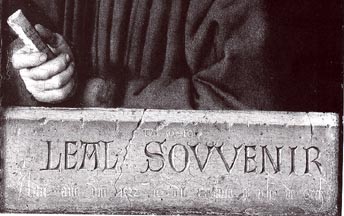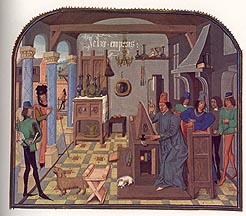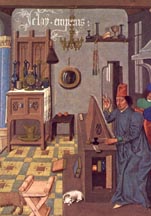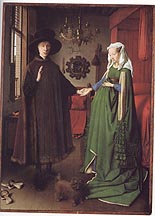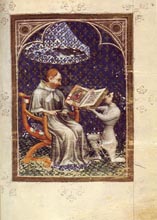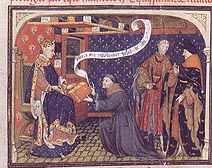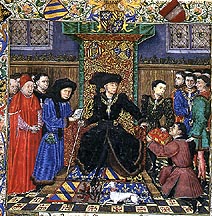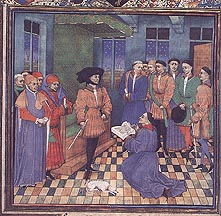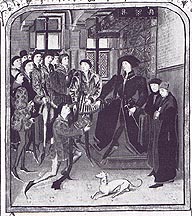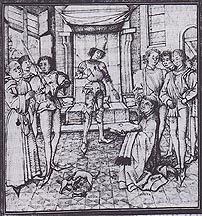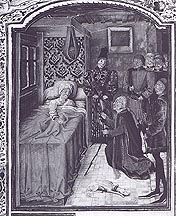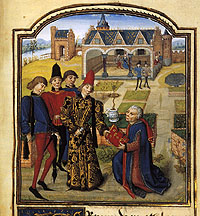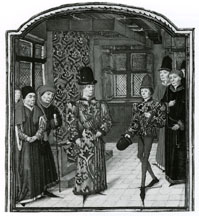Art Home | ARTH Courses | ARTH 214 Assignments| ARTH 294 Assignments | Burgundian Frontispieces
The Frontispiece to the Chroniques de Hainaut:
An Introduction to Valois Burgundy
The frontispiece introducing the Chroniques de Hainaut is probably the most frequently reproduced example of Flemish manuscript illumination. Simon Nockart, a councillor to Philip the Good, the Duke of Burgundy, commissioned Jean Wauquelin to compose a French translation of the history of Hainaut written by Jacques de Guise at the end of the fourteenth century (Annales historiae illustrium principum Hannoniae). Wauquelin's name appears for the first time in 1445. The prologue for the first volume states that the translation was completed in 1446. The accounts for Hainaut record that a copy of the translation was taken to Bruges for the Duke's approval. By March of 1448 a copy Jacquemin du Bois and maybe Wauquelin was presented to the Duke. Painted in all likelihood by 1448 but by 1452 at the latest, the miniature shows Philip the Good being presented with the Chroniques. While still controversial, it seems highly likely that Rogier van der Weyden was responsible for at least the original design of the miniature. If true, this would be the only miniature attributed to Rogier himself. This miniature can be used as a jumping off point for an introduction to Valois Burgundy. To understand the miniature we need to have an understanding of a number of different contexts:
The Historical Development of Valois Burgundy
The Order of the Golden Fleece
Court Structure and Palace Design
Conventions of Presentation Images

|
Letter
|
Name
|
Title
|
|
A
|
Simon
Nockart
|
Was secretary of the province of Hainaut. After his retirement in 1445, he was a member of the duke's advisory council. Wauquelin, in his prologue, states that Nockart was the first to encourage him to translate Jacques de Guise's work. Barely visible in the miniature is a purse signifying a government position. |
|
Jean
II le Gros the Elder
|
Audiencer of the duke's great seal, one of whose responsibilities was to seal and deliver the duke's official letters. Le Gros was a friend and close associate of Rolin. This identification was made by Van Buren, "Dress and Costume," in Cockshaw, Les Chroniques de Hainaut, p.112. | |
|
B
|
Jehan
Chevrot
|
President of the Great Council of the Duke of Burgundy; Bishop of Tournai. He wears the robe of a bishop: a red sleeveless chasuble over a sleeve surplice. Four presidents of the great council succeeded one another from 1410-83 as bishops of Tournai: Jehan de Thoisy, Jehan Chevrot, Guillaume Fillastre, and Ferry de Clugny. |
|
C
|
Nicholas
Rolin
|
Chancellor of the Duke of Burgundy. He wears a green velvet purse embroidered with gold. This purse identifies him as a government official. It is perhaps an aumônière or alms-purse. |
The Historical Development of Valois Burgundy:
Jean Wauquelin's prologue to his translation includes the passage above. This passage documents Philip the Good's role in commanding Wauquelin to make the translation. Following traditional formulas, Wauquelin identifies Philip by the titles he holds: "...philippe [underlined in red] par la grasce de dieu. Duc de bourgoigne. de lotringhe. de braiba[n]t et de lembourc. Conte de flandre. dartois. de bourgoigne. palatin de hainau. de hollande. de zelande et de namur. marquis du saint empire. seigneur de frize.de Salins et de Malines....[ Philip by the grace of God, Duke of Burgundy, of Lotharingia, of Brabant, and of Limbourg. Count of Flanders, of Artois, of Burgundy. Palatinate of Hainaut, of Holland, of Zeland, and of Namur. Marquis of Saint Empire. Lord of Frize, of Salines, and of Malines.]"
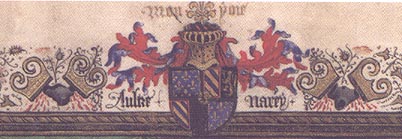
The coats of arms integrated into the border of the page reiterate this territorial control. At the top of the page appear Philip's arms, mottoes, and device, while the arms of the different territories appear along the sides and bottom of the page. On the left side are the arms of the duchies of Burgundy, Lotharingia, Brabant, and Limbourg. Next come the counties: Flanders, Artois, and Burgundy (Franche-Comté). On the right side appear the arms for Hainault, Holland, Namur, and Frisia. Thus both the translator's prologue and decoration of the frontispiece stress the extent of the Duke's territorial control. Within two generations, extending from Philip the Good's grandfather, Philip the Bold, Valois Burgundy had become a power rivalling the kingdoms of England and France. This "state" was formed through astute marriage alliances, the fortunes of inheritance, purchases, and conquest. Richard Vaughan in his Valois Burgundy presents a succinct account of the growth of Burgundian power. This expansion can be documented by comparing maps of Burgundy showing the lands controlled by Philip the Bold and Philip the Good:
A major challenge faced by the Burgundian Dukes was how to hold these heterogeneous lands together. To the south in Burgundy were the rural estates while in the north were the cities that were the center of the vital cloth industry. The territories of the north alone represent linguistic and cultural diversity. The Dukes also had to contend with the fierce local identities of these territories. One way to do this was to justify their claims to power by showing their connections to local historical narratives. This was the motivation for commissioning texts focusing on the local histories of the different domains falling under their control. The Chroniques de Hainaut can be seen as the cornerstone of this project, but it also included texts like Wauquelin's Girart de Roussillon and David Aubert's Chroniques et Conquestes de Charlemagne, Renaud de Montauban, and Histoire de Charles Martel. Wauquelin in his preface to the first volume of the Chroniques de Hainaut presents the duke as the legitimate ruler of Hainaut and traces Philip's ancestry back to the fall of Troy. Philip saw the historical parallel between the domains that fell under his control and those allotted to Lothair, the grandson of Charlemagne, in the partitioning of the Carolingian Empire in the Treaty of Verdun in 842:
Even though he lacked a royal title, Philip the Good and his delegates insisted on his high status by appealing to his ancestry. At the Council of Basel in 1433, the leader of the Burgundian delegation Jean Germain claimed seats next to those of royal and imperial envoys on the basis of the privilege of Philip's descent from the Trojan prince Francus (or Francion, the son of Hector), from the Burgundian king Gundulph, and from Pepin and Charlemagne. Germain also noted Philip's direct relationship to the royal families of France, England, Portugal, Navarre and Cyprus. A common theme in many of the texts commissioned by the Dukes of Burgundy was the ancestral privilege of the Duke of Burgundy.
Government and Court: chevaliers, conseillers, et chambellans:
"Chevaliers, conseillers, et chambellans" [knights, counsellors, and chamberlains] was a regular formula to articulate those who stood at the top of the Burgundian hierarchy under the Duke. It is this elite which is the focus of the Chroniques de Hainaut frontispiece. The positioning of the figures in the miniatures was clearly designed to reflect the structure of the Duke's government and court. Standing in front of his throne and cloth of estate, Philip, wearing the collar of the Order of the Golden Fleece, holds in his left hand a baton of power and in his right hand a small hammer, also a symbol of power. Charles de Charolais the next in the hierarchy stands to the right of Philip. This is visually suggested in the miniature by his close proximity to the duke and positioning between the presenter and the duke. His status as the first legitimate heir to Philip is perhaps reflected in the choice to have the same cloth be used for his gown and that of the cloth of estate behind Philip. This type of gold brocade fabric with meandering pomegranate patterns was known as cloth of gold and was regularly used in the ducal families clothing and in the cloths of estate.
Thus to Philip's right appear the representatives of the central government of Burgundy: the chancellor and the grand conseil. These figures are also the primary representatives of the functionary class which stemmed from bourgeois origins and dedicated their careers to the loyal service of the Duke. Immediately to Philip's right stands his "right hand man" Nicholas Rolin (C), the duke's Chancellor. In 1385, the first Duke of Burgundy, Philip the Bold, created the position of Chancellor. He appointed Jehan Canard, a lawyer who had gained fame in the Paris Parlement, to this central position. As 'chancellor of my lord the duke of Burgundy' Canard replaced the chancellors already existing in the individual territories under the Duke's control in Burgundy and Flanders. The Chancellor effectively became the head of the civil service. Canard was rewarded in 1382 for his services with the bishopric of Arras. Canard was succeeded by an important line of noblemen and burgesses. A nobleman, Jehan de Saulx, served as the ducal chancellor during the reign of John the Fearless.
The most notable Burgundian chancellor was a burgess from Autun, Nicholas Rolin, who served Philip the Good's chancellor from shortly after Philip's accession to the end of the 1450's. Like his older brother Jean, Nicholas started his career as a lawyer at the Parlement of Paris in 1401. In 1408 Nicholas was serving as a lawyer to the Burgundian Duke John the Fearless. With the assassination of Duke John in 1419 and the accession of Philip the Good, Nicholas was knighted and made Chancellor by 1422. Rolin held that position for the next thirty-five years. By the time he died at the age of 82 in 1462, Rolin had amassed a considerable personal fortune working in the service of the duke. With part of this fortune he had endowed a hospital in Beaune. He also gained extensive land holdings especially in Burgundy. The Burgundian chronicler Chastellain emphasizes Rolin's great power:
| He sought to govern everything single-handedly, whether it be waging war, making peace, or administering finances. In every matter, the duke looked to him and relied upon him principally; and in all [the duke's] lands there was no office or benefice, nor were any gifts made, either in town or in the country, which were not in his disposition and about which we was not answerable in all things [G. Chastellain (k. de Lettenhove and M. Le Baron eds), Oeuvres, 8 vols (Brussels 1864), vol 3, p. 330.] |
Coming from a comparatively modest bourgeois family, Nicholas Rolin was able to transform his family's social position. His son Jehan became the bishop of Autun and Cardinal; his middle son Anthoine became the lord of Aymeries, Autun, and Lens and served throughout Charles the Bold's reign as bailiff and captain-general of Hainault; and Rolin's third son, Guillaume, became the lord of Beauchamp.
Next to Rolin stands Jehan Chevrot (B), the bishop of Tournai and the president of the duke's grand conseil. Like Rolin, Chevrot was from a bourgeois background. The see of Tournai was granted to four successive presidents of the grand conseil between 1410-1483: Jehan de Thoisy, Jehan Chevrot, Guillaume Fillastre, and Ferry de Clugny. The Grand Council played a central role in the Burgundian state. The council served as an advisory body to the duke as well as a law court. Membership included the chancellor, one or two prelates, half-a-dozen nobles, and legists, financial advisors, and secretaries. The size of the council grew from thirteen to twenty-three members between 1433 and 1438.
To the right of Philip the Good, except for the figure of the presenter, all the figures wear the distinctive collar of the Order of the Toison d'or which identifies these figures as members of the higher (hereditary) nobility. The group is lead by apparently Antoine de Croy (G) who is dressed in black and stands behind Charles de Charolais. Antoine de Croy was the premier chambellan (First Chamberlain) of the Duke. In court culture intimacy with the prince was a sign of social status. It was the source of informal power and aroused jealousy. In the words of Olivier de la Marche, "In the prince's chamber, the chief pensionary or the (first) gentleman of the chamber must attend to putting the Prince's nightcap on his head; and the more intimate the service performed for the prince, the greater the honor." As the First Chamberlain, Antoine de Croy slept near the duke, was served with his prince at table, controlled access to the ducal chambers, guarded the duke's great seal, carried his banner in battle, and was responsible for the supervision of the household. The First Chamberlain was allowed to receive acts of homage on the duke's behalf. Antoine was the son of Jehan, lord of Croy, who served Duke John the Fearless. Although killed at the battle of Agincourt in 1415, Jehan was able to establish the family position at the Burgundian court so that Antoine was able to become a central figure in the court of Duke Philip the Good. By the 1420s he was one of the noble members of the grand conseil. Along with his brother Jehan, Anthoine was one of the original members of the Knights of the Golden Fleece, founded by Philip the Good in 1430. As the First Chamberlain, Antoine had a position at court equal to that of Nicolas Rolin, the chancellor. His will, made in 1450, indicates the considerable fortune he was able to attain in the duke's service.
Antoine was not just concerned with parlaying his position at court into monetary wealth, but he was also concerned with advancing his family's status among the nobility. He was able to persuade the duke to use his influence to get Louis de Luxembourg, the count of St. Pol, to acquiesce to the marriage of his eldest daughter to Philippe de Croy, the son of Antoine. For Louis this was a humiliation being forced to agree to a marriage of his daughter to such a low born family, descended from a mere banneret. Antoine was able to insist that Louis's daughter be brought up by the Croy until she was marriageable age.
Vaughan(Philip the Good, p. 172-173) gives us examples of the workings of this government and how the chancellor and first chamberlain played central roles between petitioners and the duke and duchess. The report of Wilhelm von Rötteln, the Austrian ambassador to Brussels in 1447, records that the ambassador first contacted Antoine de Croy and the chancellor Nicholas Rolin, who arranged an audience with the duke and duchess. The duke encouraged the ambassador to present his proposals to the council. The next morning, the ambassador had another private meeting with the duchess. Wilhelm then met with the duke's principal councillors: Antoine de Croy, Jehan Chevrot, bishop of Tournai, Jehan de Neuchâtel, lord of Montagu, and Nicolas Rolin, who promised to pass on the requests to the duke. A week later, Rolin presented to the ambassador a formal reply from the duke and duchess in their presence.
What held the government and court together was not the institutional structure but the mutual bonds of loyalty between the duke and his officials. The duke could promote or dismiss members of his court at will, and at the death of the duke, the government and court would be disbanded. The loyalties to the duke did not prevent strong rivalries and animosities between members of the court. The Burgundian chronicler Georges Chastellain devotes many pages to the rivalries between Nicolas Rolin and the de Croy family. Antoine de Croy played a central in engineering the downfall of Rolin from his position as chancellor. In 1457, a bitter dispute broke out between Philip the Good and his son Charles over the appointment of either Philippe de Croy, the son of the first chamberlain, or Antoine Rolin, son of the chancellor, to a household position.
The Order of the Toison d'Or and the Chivalric Revival:
A major cause of the rivalry between the de Croy and Rolin families was the class division between the hereditary nobility and the newly ennobled families who had bourgeois backgrounds but received their titles as rewards for their services as ducal officers and financiers. As a reaction to the economic and social changes that were transforming Europe with the rise of a wealthy merchant class, there was a resurgence of interest in codes of chivalry and solidarity among the nobility. Ancient noble families were feeling threatened by the newly ennobled families like the Rolin. The ancient families emphasized those qualities that set them apart. Traditional feudal values such as service, fidelity, and obedience were asserted. Likewise there was emphasis on the military culture of the knight with its emphasis on honor and valor. "To live nobly" meant a life dedicated to the profession of arms. Activities such as jousting, falconry, and hunting were particularly associated with the nobility as activities that were extensions of demonstrating the nobleman's prowess in arms. The de Croy family took great pride in the fact that Jehan de Croy, the father of Antoine, was killed in battle on the fields of Agincourt. There was great class resentment for those who had apparently bought their titles from the profits of their legal or financial careers. Noble birth, virtue and honor, and not financial prosperity, were the primary attributes of the true noblesse. An abstention from trade, money-lending, and manual labor marks off the true noble from his bourgeois contemporaries. For a member of the nobility to be offered money for their services could be understood as an insult. Georges Chastellain, the chronicler of the Burgundian court, could proudly state, "you have shamed me by sending me money, which I am not accustomed to taking or receiving, because I do not wish to sell my service to good men for a price." Thus this period from the fourteenth to sixteenth centuries which was marked by profound and rapid social, political, and economic changes also witnessed chivalry in many respects at its height with the hardening of class barriers and the assertion of the traditional chivalric values.
This trend was manifested in the creation or revival of orders of knighthood at the principal European courts during the fourteenth and fifteenth centuries. The Order of the Garter was founded by Edward III of England in 1348. In 1430, Philip the Good, Duke of Burgundy, on the occasion of his marriage to the Infanta Isabella of Portugal , established the Order of the Toison d'or, or the Golden Fleece. The Order of St. Michael was founded by Louis XI of France in 1469. The ideals of these orders are effectively summarized in the following excerpt from prologue of the statutes of the Toison d'or:
| We Philippe, by the grace of God Duke of Burgundy...make known to all present and to come, that for the very great and perfect love that we have for the noble estate and order of knighthood, of which from very ardent and singular affection, we desire the honor and increase, by which the true Catholic Faith, the faith of our mother, the Holy Church, and the tranquility and prosperity of the public may be, as far as possible, defended, guarded, and maintained; we, to the glory and praise of the Almighty, our Creator and Redeemer, in reverence of his glorious mother the Virgin Mary, and to the honor of my lord Saint Andrew, Apostle and Martyr; to the exaltation of virtues and good habit; on the tenth day of January in the year of Our Lord 1429 [O.S.], which was the day of the solemnization of the marriage between us and our most dear and beloved companion, Elizabeth, in our city of Bruges, we did undertake, create, and ordain, and by these presents do undertake, create, and ordain an order and fraternity of knighthood, or amiable company of a certain number of knights, which we wish to be called the Order of the Golden Fleece, under the form, condition, statutes, manner, and articles which follow [D'Arcy Jonathan Dacre Boulton, The Knights of the Crown, p. 365]. |
Membership was open to only nobles of ancient family. The statutes of the order of the Toison d'or specify that those selected for membership should be distinguished "for [their] sense, prowess, virtues, and good customs... and the confidence [the Duke] had in their loyalty and perserverance in good deeds and honorable works." Members of the order were thus expected to be the models of knightly virtue. The number of members was carefully controlled. Only twenty-five knights along with the king were granted membership to the Order of the Garter at its foundation, while the Order of the Fleece at its foundation allowed for twenty-four members along with the Duke of Burgundy. This number was later increased to thirty-one. As observed by Olivier de La Marche, it was feared that a larger membership would more likely lead to internal dissensions within the order: "if there should be more knights, more contentious matters could arise between those knights that do not make for their unity nor for the furtherance of the intentions of the [order's] head."
Uniting the upper nobility under the authority of the prince was one of the major purposes of these orders. As noted above, the territories falling under the control of the Dukes of Burgundy were marked by major differences in geography, language, law, and customs. The Flemish nobility tended to live in cities while the nobility of Burgundy were based in their rural estates. The diversity of these domains made centralisation difficult. The Toison d'or's emphasis on the allegiance and dependence upon the person of the Duke was invaluable for the Dukes of Burgundy in uniting the nobility of these disparate provinces. In a period when loyalty was becoming increasingly tied to monetary arrangements in the form of pensions and annuities, these orders were a throwback to the system of vassalage traced back to feudal society of the earlier Middle Ages. The oaths of loyalty bound members of the orders together under the authority of the prince. The statutes of the order of the Toison d'or are explicit about the exclusive loyalty of the members to the duke alone. Members were forbidden to belong to any other chivalric associations. The only exception to this rule was the provision that "emperors, kings, and dukes" could belong to their own orders as well as the Toison d'or. By the mid 1440s, Philip began to use membership into the order as a diplomatic tool by granting membership to among others King Alfonso V of Aragon, Naples, and the two Sicilies, several French princes including the dukes of Orléans, Britanny, and Alençon.
This portrait of Philip the Good by Rogier van der Weyden shows the Duke wearing the distinctive collar of the Toison d'or. The other image is a detail of a frontispiece of one of Philip's books showing the Duke's arms and again the collar of the Toison d'or. The order's insignia of the Golden Fleece is suspended from a collar decorated with the devices of the ducal house. Since the capture of John of Nevers (the future John the Fearless) by the Turks in 1396, the flint and fire-steel, striking sparks had been the personal livery collar of the Duke's household. The statutes of the Toison d'or specify that every member of the order of the Golden Fleece was required to wear this collar daily. This makes explicit the sovereignty of the Duke over the order and the allegiance of the members of the order to the Duke's household.
Court Structure and Palace Design:
"After the deeds and exploits of war, which are claims to glory, the household is the first thing that strikes the eye, and that which it is therefore most necessary to conduct and arrange well." [Georges Chastellain, Oeuvres, ed. Kervyn de Lettenhove (8 vols., Brussels, 1863-66) V, p. 364]
For the Dukes of Burgundy the magnificence of their court was of great importance in their ambitions to assert their preeminence among the courts of Europe. A useful introduction to the structure and nature of the Burgundian court is found in an excerpt from Otto Cartellieri's The Court of Burgundy.
The Burgundian court first began in the shadow of the French court, but with the instability caused by the weak reign of Charles VI, the civil war, and English invasion, the French court lost its dominant position. By the 1430's the Burgundian Court gained a dominant position even outshining the courts of England and France.
The Dukes of Burgundy had residences in Bruges, Brussels, Dijon, Ghent, Hesdin in Artois, Valenciennes in Hainault and at the Hôtel d'Artois in Paris. Save for small fragments like the Tower of John the Fearless that formed part of the Hôtel d'Artois in Paris, most of these residences are no longer extant. However, the evidence that remains suggests the strong influence of the French model. The miniature above , painted by Jan de Tavernier painted in 1460 comes from the Chroniques et Conquetes de Charlemagne (Brussels, B. R., 9066). It shows the author and scribe David Aubert presenting the text to Philip the Good. It appears to be based on one of the Pierre Salmon frontispieces:
The Aubert frontispiece makes the same division between the more private space of the ruler's chamber and the public space beyond. In what is probably the chambre à parer, Aubert is shown presenting his text to Philip the Good. Following the formula evident in the Chroniques de Hainaut frontispiece, the duke is accompanied by members of his household. The members of the order of the Toison d'or are given a prominent position, while the figure on the right holding a rolled document is in all probably the duke's chancellor or other high functionary. The miniature makes clear the exclusiveness of the space of this chamber from the courtyard outside. This appears to reflect the division of the court between what the English call the domus providencie (the Hall) and the domus magnificencie (the Chamber). This courtyard is still the space of privilege and is in marked contrast to the world outside the palace's wall. The figures in the court are distinguished by their elegant attire and courteous demeanor. The appearance of a pair of horses, a falcon, and even a dwarf attest to this as the space of court. The world beyond the palace's gates is distinguished by its commercial activity. The mongrel standing in the foreground is in marked contrast to the pedigree dog that appears regularly at the feet of the nobility in presentation images.
A valuable record of the appearance of one of the Duke's residences is presented by a seventeenth century engraving by Anthonis Sanderus of the Princenhof in Bruges:
The plan of the palace shows a series of courtyards like those illustrated in the Aubert miniature. One gained access to the principal courtyard through monumental gateway. The principal focus was the central block:
Like the plan of the Louvre, the lower level was dominated by a chapel and the hall while the multi-storied donjon contained the Duke's lodgings. Apparently following the French model, there were separate chambers for the duchess and heir apparent. Other courtyards beyond provided space for activities such as tennis and tilting. Another feature of the palace was a series of gardens. Most notably the Duke's enclosed garden can be seen just beyond the central range. While the interior arrangement of the palace are lost, the evidence provided by a series of frontispieces for books made for the Dukes of Burgundy or for individuals closely associated with the court suggests a similar interior disposition to that found in France. A good example is presented by the frontispiece for a copy of the Histoire de la conquete de la Toison d'Or made for Louis de Gruuthuse:
The author is shown kneeling before the Duke who is seated on a throne under a cloth of estate. This space corresponds to the chambre à parer or chambre parement that was the central, most formal, and most public space in the French chamber plan. Like the French plan, access to this space in the miniature is provided for by a monumental staircase, the grande vis. The chambre à parer is the most frequently represented interior space in these Burgundian frontispieces. Adjoining the chambre à parer in the Histoire de la conquete de la Toison d'Or miniature is a room containing a bed corresponding to the chambre du roi in the French plan. A miniature showing Jean Miélot presenting a copy of his Traité sur l'Oraison Dominicale to Philip the Good represents this bed chamber.
The presentation page of the translation of Quintus Curtius's Livre des fais d'Alexandre le grant (Paris, B.N. , fr. 22547, f. 1) shows Charles the Bold receiving the presentation copy of the translation in a chambre á parer with an enclosed garden in the background.
The Dukes of Burgundy can be said to have suffered the same disorder as their Valois relatives in France, what Brigitte Buettner has identified as "vello-mania." Like his great uncle Charles V, Philip the Good was active in the commissioning of new texts and translations. Philip through this activity wanted to be known as the "the Wise" like Charles V. The holdings of his collection also reveal his love of deluxe copies of the texts. These manuscripts still give visible testament to the "magnificence" of Philip's reign.
Reading of texts, especially histories and chronicles , were an important part of the daily life of the Burgundian court. David Aubert states that Philip the Good had "long been accustomed to having stories read before him on a daily basis." Philip's son Charles the Bold interests are documented by the following passage written by Olivier de la Marche:
| He never retired with having [something] read before him for two hours; and frequently seigneur de Humbercourt [Guy de Brimeau, a high-ranking court functionary and diplomat], who read and retained [texts] quite well, read before him; and at the time he [Charles] had he great stories of Rome read to him and took great pleasure in the deeds of the Romans. |
L.M.J. Delaissé, an historian of the medieval book, noted that the majority of the books associated with Philip the Good were begun in the last two decades of his reign. Although his reign extended from 1419 to 1467, it was only after 1445 that the major projects commenced. Beginning at least by 1445, Jean Wauquelin had begun the project of making translations of pluseurs hystoires des païs de mon dit seigneur [several histories of the lands of my lord]. The Duke was interested in collecting copies in French of chronicles, annals, and genealogies of the different territories he ruled. His interest in these legendary and factual accounts was certainly to justify the rightfulness of his claims to power and place his rule within the context of a broader historical perspective.
Chronicles had played an important role in justifying the legitimacy of monarchs and fostering a sense of national identity. A particularly good example is the Grandes Chroniques de France, which was initiated in the late thirteenth century but was continued into the mid-fifteenth century. Originally, the text traced the history of the French monarchy from its legendary foundation by the Trojan prince Francion, the son of Hector to the death of Philip Augustus in 1223, but the text was supplemented under later kings. The opening frontispiece of an early fifteenth-century version in the Morgan Library implies the continuity and legitimacy of the French monarchy with the story of Francion's foundation of Sicambria being superposed to an image of Charles VI being presented with a copy of the text:
The Chroniques de Hainaut were a translation of the Annales historiae illustrium principium Hannoniae written by Jacques de Guise between 1390 and 1396. Wauquelin in his introduction to his translation makes explicit the project's intention of justifying the legitimacy of the Dukes of Burgundy: plainement apparoir la noble procreacion et lignie, et comment est descendus mon dit tres redoubté et tres puissant seigneur du hault, noble et excellent sang des Troyens [ [in this book] plainly appears the noble origin and lineage and how my very famous and very powerful lord has descended from the high, noble, and excellent blood of the Trojans]. In the Chroniques de Hainaut, the foundation of Hainault is traced back to Bavo, the first prince of Belgium and said to be the cousin of King Priam of Troy.
The Chroniques de Hainaut was the first of a number translations of chronicles of lands falling under the control of Philip the Good. Jean Wauquelin worked on a translation of the Chronica noblissimorum ducum Lotharingiae et Brabantiae ac regum Francorum written by Edmond de Dynter. The translation was entitled the Chroniques des ducs de Brabant. About 1455, Philip the Good received the first translation of the Chronographia de Johannes de Bekas, a history of the county of Holland.
The account record of 1448 which includes payments to Wauquelin and Jacotin du Bois for the copying of the first part of the Chroniques also includes references to a "livre de Gerart de Roissillon et l'istoire d'Alixandre" that were also made for the Duke of Burgundy. The former book can be identified as the Roman de Girart de Roussillon. The ducal copy of this text can be identified as Vienna, Ö.N.B., Cod. 2549 (paleographic evidence that this is not the copy referred to in accounts):
The Histoire d'Alixandre or Roman d'Alexandre can be confidently identified as Paris, Bibliothèque nationale, fr. 9342:
The motivation for the creation of these last two texts can be related to the duke's ambitions and sense of identity. Philip the Good would clearly have identified with the story of the ninth-century Burgundian hero presented in the Roman de Girart de Roussillon. Controlling many of the lands that would become part of Valois Burgundy, Girart, like Philip, was a vassal of the French king, and both clashed with their feudal lord. The Carolingian context of the story also appealed to the Burgundian sense of history with placing their narrative within a larger historical context. Asserting a connection back to the Carolingians was comparable to tracing their authority back to Trojan ancestors found in the Chroniques de Hainaut.
The Roman d'Alexandre is just one witness to the Burgundian fascination with the story of Alexander the Great. A chambre of tapestries telling the story of Alexander were made for Philip the Good by Pasquier Grenier a merchant in Tournai in 1459. Costing five thousand gold crowns, this tapestry set included six wall hangings and a complete set of bed hangings. When Philip the Good accompanied King Louis XI in a triumphal entry into Paris in 1461, the Duke of Burgundy had the facade of his Hôtel d'Artois decorated with these tapestries. This clearly made the point that the Duke rather than the King of France should be considered the modern-day Alexander. A pageant representing the marriage of Alexander the Great with the daughter of the King of Egypt was included in the festivities celebrating the marriage of Charles the Bold to Margaret of York. One of the duke's secretaries, Jean Miélot, included Alexander as a participant in a fictional debate with Hannibal and the Roman consul Scipio as which of them enjoyed the greatest renown during his lifetime. In 1468, a Vasco de Lucena, a Portuguese courtier in the entourage of the duchess of Burgundy, completed a French translation of the life of Alexander written by Quintus Curtius. The copy made for Charles the Bold is currently in the Bibliothèque nationale in Paris (Ms. f. 22547) has a frontispiece showing the presentation of the text to Charles the Bold:
A deluxe copy of this text is currently in the Getty Collection:
In the introduction to this text, Vasco de Lucena compares the young prince to the great hero of antiquity. Philip the Bold, John the Fearless, King John of Portugal, and Philip the Good are characterized in the introduction as Alexandres de leurs temps [Alexanders of their time]. Of particular interest for the later Middle Ages was an appreciation of the magnificence of the court of Alexander. In our discussion of the patronage of Charles V we have already noted how Nicole Oresme drew the parallel between himself as a new Aristotle to Charles V as the Alexander:
| Confident of the help of Our Lord Jesus Christ, at the command of the most noble and most excellent Prince Charles, by the grace of God, king of France, I propose to translate from Latin into French some books written by Aristotle, the supreme philosopher, who was the teacher and counsellor of the great king Alexander. |
This parallel is clearly made in a frontispiece to Le Livre des Secrets. The original of this text was traditionally believed to have been written by Aristotle. The frontispiece to the copy in the Bibliothèque nationale (fr. 562) is clearly derived from the conventions of Burgundian frontispieces, and shows Aristotle presenting his text to Alexander the Great:
The Burgundian dukes and members of their court were interested in making the comparison to the court of Alexander. Parallels were drawn between Jan Van Eyck, the duke's court painter, and Apelles who served the same function at the court of Alexander. A mid sixteenth-century Ghent humanist, Lucas de Heere, referred to Jan in a poem as den vlaamschen apelles, the Flemish Apelles. Francisco Pacheco, the teacher and father-in-law of Velazquez, refers in his biography of Hubert and Jan van Eyck (Book 3, Chapter IV) to the intimate relationship between Jan and the Duke, which was "like the ancient Apelles with Alexander." This parallel helps explain Jan Van Eyck's portrait entitled Leal Souvenir:
The "Timotheos" referred to in the inscription on the ledge in this portrait is understood to refer to the court musician of Alexander the Great. The painting now in the National Gallery of London is probably a portrait of Gille Binchois who served the same function at the court of Philip the Good. The legalistic wording of the artist's signature (actum anno domini 1432. 10.die octobris a jan de eyck) follows formulas derived from the Burgundian chancery. The inscription Leal souvenir called attention to the loyalty that bound a court together around the authority of the prince and to the artist's technique to faithfully capture the likeness of the sitter. It is the latter characteristic that established the visual likeness between the work of Van Eyck and the reputation of the work of Apelles. Accounts of the court of Alexander the Great emphasized his familiarity with members of his court. This was especially true of the relationship between Alexander and Apelles. Alexander was said to have made visits to the studio of Apelles to watch his favorite artist work (Pliny, N.H., XXXV, 85) . The historical parallels between this and the duke's own visit to Jan's house to inspect his work would not have been missed (Panofsky, Early Netherlandish Painting,I, p. 179). The theme of Alexander's "familiarity" with members of his court helps to explain a curious miniature showing Charles the Bold surprising David Aubert from his Histoire de Charles Martel (Brussels, Bibliothèque royale, ms. 8):
Loyset Liedet who apparently painted this miniature before 1472 with the details in the background of this miniature was undoubtedly making a parallel to the now deceased Apelles of the reign of Philip the Good:
The parallels to Van Eyck's famed Arnolfini portrait can not be missed. In the miniature the Arnolfini's Fido has turned towards the Duke and is apparently the first to note the presence of the duke.
Conventions of Presentation Images:
The Chroniques de Hainaut frontispiece is clearly based on the tradition of presentation images going back to the patronage of Charles V of France. The emphasis on individualised portraiture and the theme of "familiarity" of the prince to members of his court was an important theme in presentation images of Charles V like the Vaudetar Bible:
These conventions were continued in the reign of Charles VI. A frontispiece showing Pierre Salmon presenting a copy of his text to Charles VI makes a particularly good comparison to the Chroniques de Hainaut presentation image:
The thrones and cloths of estate suggest that both images are set in the chambre à parer or the chambre de parement, what the English called the Presence Chamber that was typical of palace design since the fourteenth century. Another characteristic of both miniatures as well as the Vaudetar Bible frontispiece is the emphasis on illusionistic space. Rather than seeing the increased confidence in rendering space evident in these miniatures as evidence of the increased naturalism of the art of this period, the decision to emphasize the interior spaces in each of these miniatures was perhaps intended to articulate the hierarchy of social space in palace design and the importance of the chamber as the center of power. Direct access to the space of the prince, whose public and private personae were becoming increasingly differentiated, was open to those of the highest rank. Individualised portraiture is also characteristic of these images. The identification of the figures in the Salmon miniature reminds us not to be fooled by the "reality effect" of this image to assume that it represents a faithful record of the actual presentation. Besides the distinctive likeness of Charles VI on the left, the two figures on the right have been identified as Filippo Maria Visconti and Duke John the Fearless of Burgundy, on the far right. It was John the Fearless who was responsible for the assasination of the King's brother Louis of Orléans who was married to Valentina Visconti. The inclusion of these bitter rivals in the miniature was apparently intended to reflect the desire for peace and unity under the reign of Charles VI that was a central theme of Salmon's text. The lay out of the Chroniques de Hainaut miniature shows Philip the Good uniting the major divisions of his court. The factionalism dividing Rolin and the de Croy family noted above was overcome by the personal ties of loyalty to the Duke. The orderly disposition of figures around the Duke thus emphasizes the ideal of the prince as the center of order in the state.
The success of the Chroniques de Hainaut frontispiece in giving visual testament to the ideology of the Burgundian court is reflected in the number of frontispieces that are unmistakeably derived from it. The translator of the Chroniques de Hainaut, Jean Wauquelin was commissioned by Philip the Good to make an Alexander manuscript and prose account of Girart de Roussilon. Both of these have frontispieces related to the Chroniques. The Roman d'Alexandre (Paris, Bibliothèque nationale, fr. 9342) which the account records cite as being produced concurrently with the Chroniques de Hainaut has a closely related frontispiece:
The Duke's personal copy of the Roman de Girart de Roussillon (Vienna, Ö.N. B. , Cod. 2549) also has a frontispiece dependent on the Chroniques de Hainaut:
The frontispiece of Le Livre du gouvernement des princes by Aegidius Romanus (Brussels, B.R., ms. 9043), dated to 1452, provides a critical terminus ante quem for the Chroniques de Hainaut image:
In this miniature attributed to the Master of the Ghent Privileges, the figure of Charles is significantly older than the adolescent shown in the Chroniques de Hainaut frontispiece.
In all of these images, while clearly asserting the central position of the duke, a balance is maintained between the group of functionaries to the left with Rolin and Chevrot again being given prominent positions and the group of noblemen wearing collars of the order of the Toison d'or to the right. The artist of each of these images seems to have been interested in maintaining this balance between the two sides. This is most evident with the clear symmetry of the Roman de Girart de Roussillon image. One of the accomplishments of the Chroniques de Hainaut design is the way it maintains the balance without resorting to traditional symmetry. The asymmetry of the composition with the Duke being placed to the left helps to achieve the atmosphere of intimacy of the duke with members of his court. By placing the smaller group associated with Rolin more in the foreground, the designer has been able to balance it with the larger group of nobles on the right. The use of color, especially the red of Chevrot's robes and the gold of the cloth of estate behind Philip, was another way the designer was able to balance this asymmetrical composition.
The balance observed in these images is not found in other frontispieces which also seem to have been derived from the Chroniques de Hainaut image. One of these is from the Livre de l'Instruction d'un Jeune Prince written by Guillebert de Lannoy (Brussels, Bibliothèque royale, ms. 10976):
While the dependence of this miniature on the Chroniques de Hainaut frontispiece is unmistakeable, the artist has clearly tipped the balance to the group of noblemen who dominate the left side of the composition. The figures of Rolin and Chevrot are again present, but here they have been pushed into the right corner. They are placed well below the eye-level of the Duke and the nobles, and although they are placed more in the foreground, their scaling is noticeably smaller than that of the nobles and clearly dwarfed by the gigantic scaling of the seated Duke. The fine brocades of the clothing of the noblemen are in stark contrast to plainer fabrics of the figures on the lower right. The author of this text, Ghillebert de Lannoy (1386-1462), was from one of the most prominent noble families and he was a counsellor of Philip the Good and a member of the Order of the Golden Fleece. The text is a major document in the contemporary debate about the nature of nobility.
Another frontispiece related to the Chroniques de Hainaut is from Le Débat (or La Controverse) de noblesse (Copenhagen, K.B., Thott 1090, 4o), a translation, completed in 1449, by Jean Miélot of the De Nobilitate of the Italian humanist Buonaccorso da Pistoia. The thrust of this text which is in the form of a debate between an idle man of noble birth and an active man of humble origins privileges the Italian civic humanist ideal of the virtuous man as the one engaged in rational activity. For the Italian audience, this text was intended to draw a stark antithesis between birth and virtue, but the northern audience apparently received the text in a different way. It is not without significance that copies of this text were dedicated to hereditary nobles, and the northern audience apparently did not see nobility of birth and nobility of virtue as being mutually exclusive. The hereditary nobility in the north believed in an inherited virtue which was manifested in the ideal of noble conduct which set them apart from the rest of society.
This frontispiece, apparently done by Jean Miélot himself, clearly privileges the ancestral nobility who dominate this scene. Only the figure at the far left can be identified as a bourgeois functionary. His gesture towards the duke goes unnoticed while his access to the space of the duke is blocked by the noble bearing a sword. The duke's armor clearly establishes his identity as a noble. A fight has broken out over a bone between the usually passive dogs in the foreground.
A striking example of the authority of the Chroniques de Hainaut frontispiece is presented by a manuscript in the Arsenal collection in Paris. The manuscript is apparently one of two copies of two texts by Guillebert de Lannoy (1386-1462) that Charles the Bold paid Jean Hennecart for illuminating on September 20, 1470. Elements of the Chroniques de Hainaut frontispiece can be seen in each of the three miniatures. The first miniature opens the L'Instruction d'un jeune prince, an advice book on good conduct for a young prince. Guillebert de Lannoy structures his advice in the context of the story of an ancient king of Norway, King Ollerich, who on his death bed instructs his trusted advisor Foliant de Ionnal to write an advice book for the young Prince Rudolph. Instead of the traditional presentation image like that found in Philip the Good's earlier copy of the same text (Brussels, Bibliothèque royale, Ms 10976), Hennecart painted a miniature showing King Ollerich instructing Foliant de Ionnal. The group on the right along and the sleeping dog in the foreground in the Arsenal miniature are dependent on Chroniques de Hainaut frontispiece. Significantly the young prince echoes the dress and pose of Charles in the Chroniques de Hainaut frontispiece. At first sight the second miniature showing Foliant presenting his text to Prince Rudolph appears strikingly different from the Chroniques frontispiece. The setting is a pleasure garden with groups of lovers in the background. Clearly Rudolph is in need of advice to resist the temptations of pleasure. The figure of Foliant is borrowed from Wauquelin /Nockart figure and Rudolph's pose again echoes that of Charles from the Chroniques miniature. The third miniature in the Arsenal manuscript opens a second text, Guillebert de Lannoy's Enseignements paternels. This miniature most closely follows the Chroniques frontispiece with the left hand group closely borrowed from the earlier miniature. Significantly the father in the Arsenal miniature corresponds to the figure of Philip the Good. The borrowings from the Chroniques frontispiece clearly reinforce the message of the text. That the Arsenal manuscript was completed between 1468, the date of Charles the Bold's marriage to Margaret of York whose initials appear in initial on folio 66, and 1470, when Hennecart was paid for the illumination, suggests the timeliness of these texts. After Philip the Good's death in 1467, a major concern at the Burgundian court was Charles' fitness to take on the responsibilities of the Duke of Burgundy.
Bibliography:
Cockshaw, Pierre and Christiane Van den Bergen-Pantens, Les Chroniques de Hainaut ou les Ambitions d'un Prince Bourguignon, Turnhout, Belgium, 2000.
Paravicini, Werner, "The Court of the Dukes of Burgundy: A Model for Europe?" in Ronald G. Asch and Adolf M. Burke, Princes, Patronage, and the Nobility: The Court at the Beginning of the Modern Age, Oxford, 1991, pp.69-102.
Relevant web pages
Art Home | ARTH Courses | ARTH 214 Assignments| Burgundian Frontispieces
